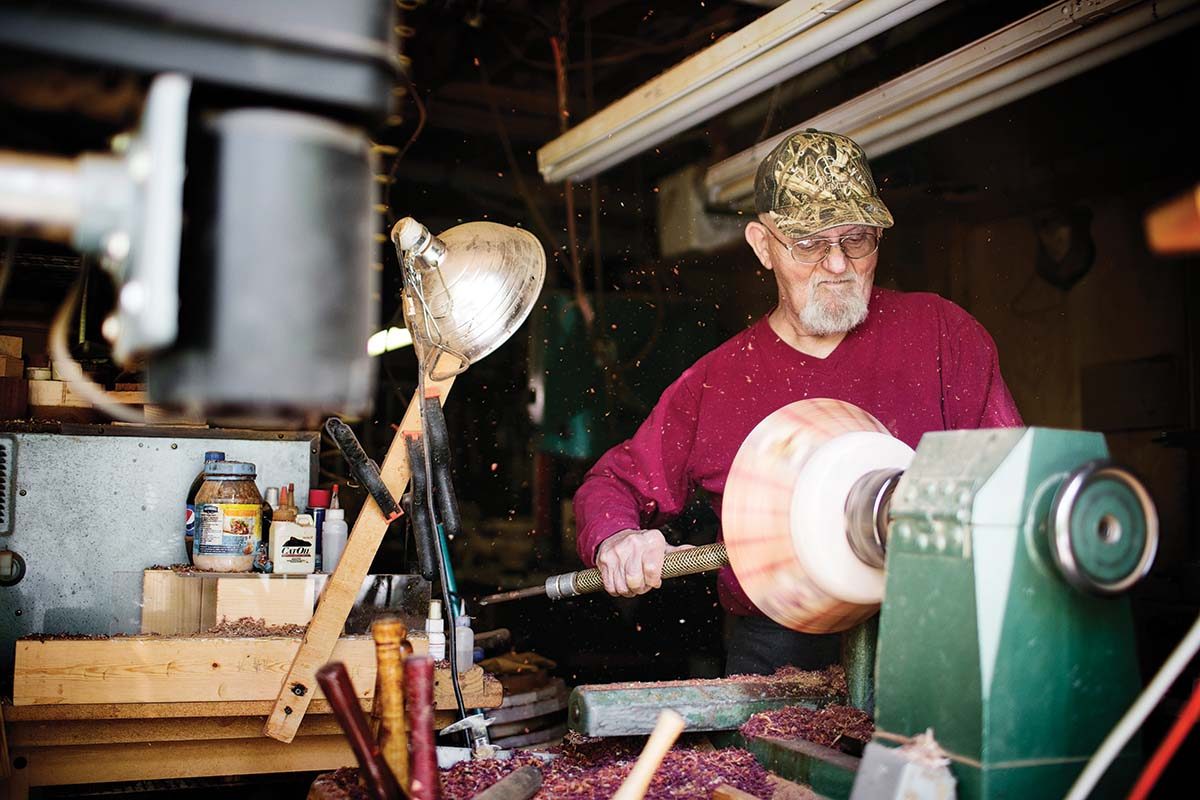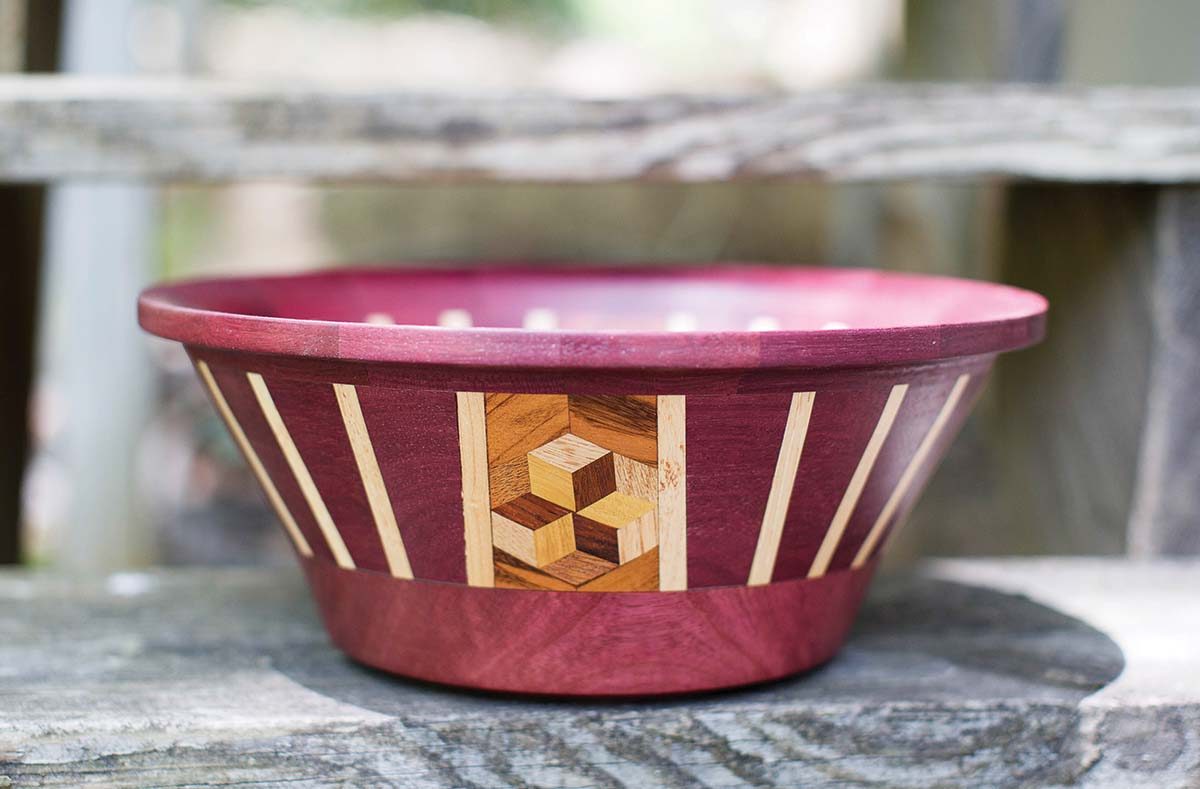Woodturner’s remarkably complicated vessels are all meant to be used

Photo by Colby Rabon
When Allen Davis retired to the mountains of North Carolina 25 years ago, after an executive career in his native Florida, one of his first projects was setting up a home woodworking shop filled with such an impressive array of power tools that a visitor might have concluded he’d been working with wood all his life. But Allen’s only previous work with wood had been in his high school’s mandatory shop class, where he managed to produce one bowl. But there’d been something about the feel and smell of wood, the shaping and finishing of such an essential natural material, that had stayed with him.
Haywood Community College was nearby and offered a woodworking class as part of its professional crafts program. “The first evening of the class, I discovered their wood lathe in the back corner of the classroom,” Davis remembers. “As they say, the rest is history.” The lathe was the tool that helped him create the distinctive line of wood bowls, trays, platters, urns, Lazy Susans, and Ikebana vases bearing his signature polychromatic and segmented shapes made from both native and exotic woods.

Photo by Colby Rabon

The contrast between light and dark, round and square shapes, against the natural beauty of the background that encompasses them lends a multidimensional and painterly character to the pieces. His designs are drawn from almost anywhere — his wife’s quilting patterns, Native American iconography, even a drawing of the solar system Davis once came across.
“The geometrics of construction continue to appeal to my engineering background,” Davis says of the technique he first saw exhibited by noted woodturner Don Russell, a fellow member of the American Association of Woodturners, and with whom Davis studied at the John C. Campbell Folk School in Brasstown. He’s since gone on to teach the craft to others.

Photo by Colby Rabon
At first glance, his work might be taken for inlays like intaglio or marquetry, but closer inspection shows that the forms appear on the inner as well as the outer surface of each vessel. “Segmented woodturning is not a surface treatment that creates the design,” Davis explains. “The precision cuts are glued together to create a patterned blank for turning. It’s a very long process. The design goes entirely through the piece.”
For one of his signature bowls, he starts with a bottom section made of several laminated layers, then moves on to the walls of the middle portion, gluing each block of cut pieces into a circle held together with rubber banding and left to dry before it goes to the lathe for turning. Finally, a ring that forms the rim of the piece is attached, and the completed assembly returns to the lathe for more turning and finishing. At any one time, he may have eight or ten pieces in various stages of the process.

“As I design each piece, I visualize it mentally,” says the artisan. “Occasionally I’ll sketch a design for a commissioned work to convey an idea to a client … I may even create a sample to illustrate my vision.” He says he enjoys the challenges of commissions, which often come with an emotional dimension. One customer brought her own piece of oak from her family’s generations-old homeplace, from which Davis produced a collection of bowls and platters for each of her four children, keepsakes to pass on to future generations. His most complex design for a lidded urn is made from more than 20 types of wood and includes 250 separately cut pieces. Davis doesn’t use stains or dyes, “only food-safe natural oils and waxes. And every piece I make is functional.”
Exotic woods like asian palm, snakewood, ebony, and marblewood find their way into the vessels, often sourced from the leftovers of other woodturners, since Davis’ work can make good use of remnants too small for more traditional turning. Native woods — black walnut, oak, and hickory among them — are harvested from his own property’s ten acres of woods and fields. “I’m always looking for burls of any species,” Davis notes, “because of their amazing grain and patterning.”
His devotion to the craft stems from that early exposure so many years ago in a high-school shop class. “It comes from the wood itself as I experience it coming alive on the lathe,” he says, “cutting away the unwanted parts to find the desired heart of the piece.”
Allen Davis, Winchester Woodworks, Waynesville. Davis sells his work in the following WNC locales: Twigs & Leaves Gallery in Waynesville (98 Main St., twigsandleaves.com); Allanstand Crafts at the Folk Art Center (382 Blue Ridge Pkwy.) and the related Guild Craft Shop (930 Tunnel Road), both in Asheville; New Morning Gallery in Biltmore Village, Asheville (7 Boston Way, newmorninggallerync.com); Jarrett House Gift Shop in Dillsboro (100 Haywood Road, jarretthouse.com); and in additional venues in the region and across the contiguous United States and Alaska. The artist will appear this summer at the Craft Fair of the Southern Highlands, held Thursday, July 18 through Sunday, July 21 at the US Cellular Center in Asheville (southernhighlandguild.org). For more information, see winchesterwoodworks.net.
